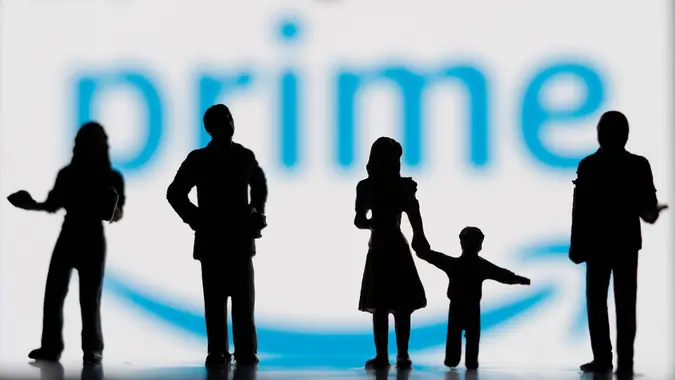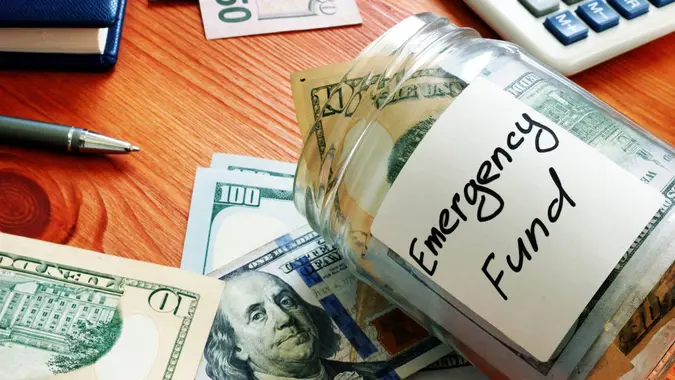How to Save $3,000 in 3 months: Simple, Fast Strategies That Work

Commitment to Our Readers
GOBankingRates' editorial team is committed to bringing you unbiased reviews and information. We use data-driven methodologies to evaluate financial products and services - our reviews and ratings are not influenced by advertisers. You can read more about our editorial guidelines and our products and services review methodology.

20 Years
Helping You Live Richer

Reviewed
by Experts

Trusted by
Millions of Readers
Need to save $3,000 fast? Whether you’re building an emergency fund or preparing for a big purchase, saving this amount in just three months is possible — even on a modest income. Check out how to budget smarter and learn tips on how to save $3,000 in three months.
How to Save $3K in 3 Months or Faster
To meet your goal of saving $3,000 in as quickly as three months, you must set aside $1,000 or more each month. This requires a combination of budgeting, expense reduction and possibly increasing your income. Here’s a table of benchmarks you need to reach daily, weekly and monthly to achieve your $3,000 goal.
Plan to Reach $3,000 Savings Goal in 3 Months
| Time Period | Amount You Need To Save |
|---|---|
| Time Period | Amount You Need to Save |
| Daily | $33.33 |
| Weekly | $230.77 |
| Monthly | $1,000.00 |
Breaking down your savings goals by day, week and month can help you set clear strategies to meet them.
How To Save $3,000 in 3 Months: Step-by-Step Guide
Careful planning and prioritization are key to achieving your $3,000 savings goal. Here are some steps you can take to make this possible:
Track Your Spending
How much are you spending on those daily lattes before work? Or how much does it cost to get that pedicure?
Tracking your spending via a notebook or an app like You Need A Budget (YNAB) or Rocket Money can give you a clear picture of how much you are spending on essentials and nonessentials. It’s the key to help you understand what you need to cut from your spending.
Build a Bare-Bones Budget
Once you know your expenses, the next step on your savings journey is to build a bare-bones monthly budget. Here’s how to get started:
- Make a list of all your essential expenses. This includes the following: rent/mortgage, utilities (electricity, water, basic internet), groceries (no dining out), transportation (gas, transit pass), insurance (health, car, renters) and minimum debt payments.
- List your nonessential expenses. You’ll note any dining-out expenses, entertainment expenses and travel.
- Add your essential expenses and leave out your nonessential expenses. This number will represent your bare-bones budget.
- Compare your take-home income with your bare-bones budget. This will help you understand how much wiggle room you have in your budget for non-essential expenses.
- Set aside extra money. If you have any money remaining after essential expenses are accounted for, deposit it into your savings account or emergency fund.
- Bridging the savings gap. If reducing dining out, canceling unused subscriptions or pausing impulses gets you to your savings goal, that’s a win. But if you’re still not quite hitting the mark, you can bridge the gap with simple income boosters: selling unused items, getting a few more hours at work, or working a side hustle like tutoring or pet sitting.
Pause Subscriptions or Services
Are there services you can cut out? You may have Hulu and Netflix subscriptions and need to eliminate both to move toward your $3,000 savings goals. Are there other services that you don’t need? List all your subscriptions and services and decide what needs to go.
Switch to Cash-Only Spending
Using cash for as many transactions as possible can help you save as you’ll have a limited amount of money to spend on those categories where it might be easier to overspend.
- Cash-only spending can work by setting up “envelopes” for specific categories.
- After reviewing your budget, decide which categories will be “cash-only.”
- Create cash envelopes for these categories and place your budgeted amount in each one. Once the cash is gone for that envelope, there’s no more spending in that category unless you move money from another envelope.
Boost Your Income Fast
If after tightening your budget and reining in your spending you’re still falling short of your $3,000 savings goal, the next step is to look for ways to boost your income. Here are some options:
- Take on a side hustle. You can start to freelance or consider driving for Uber or Lyft to make extra cash.
- Sell unused items. If there are items that you own that you aren’t using, consider selling them to make extra cash. Some platforms to sell your items on are Facebook Marketplace and OfferUp.
- Turn skills into cash. Is there a skill that you can turn into cash? Consider babysitting or tutoring as possible ways to earn extra money.
Smart Money Tools to Maximize Your Progress
Working hard is great, but you want to work smart to see your money grow fast. There are tools you should explore to boost your savings:
- Automate your savings. Use your paycheck to your advantage by directly depositing the amount you’ve decided to save into your savings account. This approach takes the thinking out of saving money. Many banks make it easy for you to set up recurring transfers from your checking account to your savings account. If you’re self-employed and don’t get a direct deposit, this is a convenient option.
- Try a no-spend challenge. Designate certain days or weeks as a time not to spend money. Decide which categories you don’t want to spend money on and make exceptions for essentials.
Explore Low-Risk Short-Term Investments
There are ways to get to your savings goal faster with certain investment tools. Keep in mind that these investments are subject to market volatility, so you should be aware of the risk. Here’s a comparison table of CDs, high- yield savings and short-term treasury bills:
Savings Option Comparison
| Option | Estimated APY | Liquidity | Risk |
|---|---|---|---|
| High-yield savings account | Ranges from 3.88% to 4.66% | High — you can withdraw at any time. | Minimal risk |
3-month CD |
Ranges from 4.25% to 4.40% | Low — you will face an early withdrawal penalty. | Minimal risk |
| 3-month treasury bill | Up to 4.22% | Moderate — treasury bills can be sold on the secondary market. | Very low — backed by U.S. government |
What If You Don’t Earn Enough to Save $1,000/Month?
If you’re not in a financial position to save $3,000 over three months, this doesn’t mean you shouldn’t work toward a savings goal. You can even save money on a low income. You may just have to adjust your expectations. Here are some tips:
- Lower your savings goal. Aim to save $500 per month and extend the timeline.
- Apply for aid. Use government or community assistance programs temporarily to redirect cash flow. A government agency that may come in handy is USA.gov.
Final Take
Saving $3,000 in just three months may require some extra work and financial discipline — but you have multiple strategies that can help meet your goals. With the right plan and a few trade-offs, you can build savings consistently and gain confidence in your financial future. Start today and watch your progress add up fast.
FAQs
- Can I save $3,000 in 3 months on a low income?
- Yes, it can be possible, but it may require strict budgeting. To meet the $3,000 goal, you must save $1,000 monthly, which means $250 weekly. Find out if that goal is realistic based on your take-home income and expenses.
- What's the easiest way to cut $1,000 from my monthly expenses?
- Start by understanding what big-spending categories cost you the most every month. For instance, if it's dining out, look for ways to plan to eat at home. If your rent takes a significant chunk of your income, consider moving to a cheaper place. Look to pause nonessential spending, too.
- What should I do if I fall behind on my savings goal?
- Re-adjust your expectations and set a lower savings goal to gain momentum. Consider selling items you aren't using or try to find a side hustle to earn extra money. Find ways to save consistently to gain traction on your goals.
- Are short-term savings accounts better than CDs?
- It depends on your financial goals. A short-term high-yield savings account can provide decent interest and liquidity. A CD may earn you a higher APY, but your funds are locked up for the term. The CD is a better option if you don't need access to the funds.
Editor's note: This article was produced via automated technology and then fine-tuned and verified for accuracy by a member of GOBankingRates' editorial team.
 Written by
Written by  Edited by
Edited by 

























